Maternity Leave Policy Template
Maternity Leave Policy
1. Purpose
This policy outlines [Company Name]'s maternity leave benefits and procedures to support employees during pregnancy, childbirth, and the postpartum period. We are committed to providing a supportive environment for expecting parents while maintaining compliance with applicable laws and regulations.
2. Scope
This policy applies to all female employees of [Company Name] who are expecting a child, including full-time, part-time, and contract employees who meet the eligibility requirements.
3. Eligibility
Employees are eligible for maternity leave benefits after completing [insert time period, e.g., 6 months/1 year] of continuous service with the company. Employees who do not meet this requirement may still be entitled to unpaid leave as required by law.
4. Leave Entitlement
4.1 Duration
Eligible employees are entitled to [insert number, e.g., 12-16] weeks of maternity leave
Leave may commence up to [insert number, e.g., 2-4] weeks before the expected delivery date
Additional unpaid leave may be available upon request and approval
4.2 Paid vs. Unpaid Leave
[Insert number] weeks of maternity leave will be paid at [insert percentage, e.g., 100%/75%/50%] of base salary
Any remaining leave will be unpaid, subject to applicable laws
Employees may use accrued paid time off (PTO) or sick leave to supplement unpaid portions
5. Notice Requirements
Employees should notify their supervisor and Human Resources of their pregnancy and intended leave dates as early as possible, preferably at least [insert time period, e.g., 30-60] days before the anticipated start date. Notification should include:
Expected delivery date
Proposed leave start and end dates
Plans for work coverage during absence
6. Medical Certification
Employees may be required to provide medical certification from their healthcare provider confirming:
Expected delivery date
Any medical necessity for leave prior to delivery
Fitness to return to work following leave
7. Benefits During Leave
7.1 Health Insurance
Health insurance coverage will continue during maternity leave under the same terms as if the employee were actively working
Employees remain responsible for their portion of premium contributions
7.2 Other Benefits
Accrual of vacation/PTO may continue for paid leave periods as specified in company policy
Retirement plan contributions and matching will continue according to plan terms during paid leave
Employees will not accrue seniority or service credit during unpaid leave portions
8. Return to Work
8.1 Position Guarantee
Employees returning from maternity leave will be restored to their original position or an equivalent position with equivalent pay, benefits, and terms of employment
Employees should confirm their return date with Human Resources at least [insert time period, e.g., 2 weeks] before the scheduled return
8.2 Extension of Leave
Requests to extend maternity leave beyond the standard period must be submitted in writing to Human Resources at least [insert time period, e.g., 2-4 weeks] before the scheduled return date
Extensions are subject to approval and may be granted as unpaid leave
8.3 Flexible Return Options
Employees may request flexible work arrangements upon return, such as reduced hours, remote work, or adjusted schedules
Such requests will be considered on a case-by-case basis depending on business needs and position requirements
9. Lactation Support
[Company Name] provides private, non-bathroom space for nursing mothers to express breast milk during working hours. Reasonable break time will be provided for this purpose as required by law.
10. Coordination with Other Leaves
Maternity leave may run concurrently with other available leaves including:
Family and Medical Leave Act (FMLA) leave (if applicable)
Short-term disability benefits
State-mandated pregnancy disability leave
Other applicable statutory leaves
11. Compliance with Laws
This policy is designed to comply with applicable federal, state, and local laws including but not limited to:
Family and Medical Leave Act (FMLA)
Pregnancy Discrimination Act (PDA)
Americans with Disabilities Act (ADA)
State and local pregnancy and parental leave laws
Where state or local law provides greater benefits or protections, those laws will apply.
12. Non-Discrimination
[Company Name] prohibits discrimination or retaliation against employees who take maternity leave or request accommodations related to pregnancy, childbirth, or related medical conditions.
13. Contact Information
For questions about this policy or to initiate maternity leave, please contact:
Human Resources Department: [email/phone]
Benefits Coordinator: [email/phone]
14. Policy Review
This policy is subject to change at the company's discretion. Employees will be notified of any material changes. This policy was last updated on [Date].
Acknowledgment
I acknowledge that I have received, read, and understand the Maternity Leave Policy. I understand that it is my responsibility to comply with this policy and to direct any questions to Human Resources.
Employee Signature: _________________________ Date: _____________
Employee Name (Print): _________________________
Maternity Leave Policy Template
Maternity Leave Policy
1.PURPOSE:
1.1. To standardize the processing of Maternity Leave.
1.2. To notify all employees about the policy and procedure.
2.POLICY
2.1.Maternity Leave application must be booked as soon as the member of staff is confirmed pregnant; department head must be informed as soon as the pregnancy is confirmed, and this must be entered into the department’s leave plan, so that support for the service affected can be planned during this extended period of time that the employee is away. A 60 day limit applies here; extensions to this period of time must be approved by the COO/CEO.
2.1.1.Annual leave planning includes the number of people allowed on leave at any one time from a department. This number of people includes staff on Maternity leave.
2.2. Maternity leave governance is as per the normal annual leave procedure including cancellations and changes of dates, and departmental requirements of service, notwithstanding the employee’s rights.
2.3. The employee will be paid her full salary for 45 consecutive days including the period preceding and the period following her confinement, on condition that she has been in service for a continuous period of not less than one year by the time she delivers.
2.3.1.If she has not completed the aforesaid period of service, she shall be entitled to maternity leave with half pay according to Labor Law criteria.
2.3.2.On the expiry of maternity leave a female worker may be absent from her work without pay for maximum period of 100 consecutive or non-consecutive days if such absence is due to an illness (medical report required) preventing her from resuming her work.
2.4. If Maternity Leave is cancelled or needs to be postponed then the existing leave application must be withdrawn and a new application should be resubmitted.
2.5. The duration of the maternity leave is in accordance with the labor law; in case of premature delivery, all usual benefits apply.
2.6. The entitlement of rest periods after maternity leave will be in accordance with the labor Law
3.PROCEDURE
3.1.The Employee will notify the head of department of the confirmed pregnancy and the tentative due dates.
3.1.1.The head of department will immediately enter the planned maternity dates on the annual leave plan so that staff are aware that the slots allocated for annual leave during that time may be affected.
3.2. An online application form must be submitted one month before the delivery date.
3.3. Employee will get the system notification on leave approval within 2 to 5 working days from the respective Department manager and the HR manager.
3.4. Employees leave record will be updated in the system for future reference with access to the HR & Payroll departments respectively.
3.5. Employee can resubmit a revised leave form by withdrawing/cancelling the existing application and resubmitting a new leave application with revised dates.
4.REFERENCES
4.1. Labor Law
5.ATTACHMENTS
None
REVIEWED BY : ______________________________
SIGNATURE : ___________________
DATE : ___________________
APPROVED BY : ______________________________
SIGNATURE : ___________________
DATE : ___________________
Employee Request for Maternity Leave - Formal
Subject: Maternity Leave Request
Dear [Manager's Name],
I am writing to formally request maternity leave in accordance with company policy and applicable regulations. My expected due date is [Date], and I would like to begin my leave on [Start Date].
I am requesting [Number] weeks of maternity leave, with an anticipated return date of [Return Date]. I understand this may be subject to adjustment based on medical circumstances, and I will keep you informed of any changes.
During my absence, I propose the following arrangements to ensure continuity of my responsibilities: [Brief outline of coverage plan]. I am committed to completing all critical projects before my departure and will prepare comprehensive handover documentation for my colleagues.
I have attached the required medical documentation confirming my pregnancy and expected delivery date. Please let me know if you require any additional information or documentation to process this request.
I would appreciate the opportunity to discuss this request with you at your earliest convenience to finalize the arrangements and ensure a smooth transition.
Thank you for your understanding and support during this important time.
Sincerely,
[Your Name]
[Your Position]
[Date]
Employer Approval of Maternity Leave - Official
Subject: Approval of Maternity Leave Request
Dear [Employee's Name],
We are pleased to confirm approval of your maternity leave request as outlined in your communication dated [Date].
Your maternity leave is approved as follows:
Leave Start Date: [Date]
Expected Return Date: [Date]
Total Duration: [Number] weeks
You are entitled to [specify paid/unpaid leave details] in accordance with [company policy/applicable law]. Your benefits will continue during your leave period as per our standard policy.
During your absence, [Colleague's Name] will assume responsibility for your primary duties. We have arranged a transition meeting scheduled for [Date] to ensure proper handover of your responsibilities.
Please submit any outstanding documentation, including final medical certificates, to the Human Resources department by [Date]. You will receive separate communication regarding benefit continuation, payroll adjustments, and return-to-work procedures.
We wish you all the best during this exciting time and look forward to your return.
Best regards,
[Manager's Name]
[Title]
[Company Name]
[Date]
Employee Extension Request - Professional
Subject: Request for Maternity Leave Extension
Dear [Manager's Name],
I am currently on maternity leave, which was scheduled to conclude on [Original Return Date]. I am writing to request an extension of my leave for an additional [Number] weeks, with a revised return date of [New Return Date].
This extension is necessary due to [brief explanation: medical recovery complications/childcare arrangements/bonding time/doctor's recommendation]. I have attached supporting documentation from my healthcare provider regarding this matter.
I understand this may require adjustments to the current coverage arrangements, and I apologize for any inconvenience this may cause. I remain committed to returning to my position and resuming my responsibilities as soon as circumstances permit.
Please let me know if you need any additional information to consider this request. I am available to discuss this matter at your convenience.
Thank you for your continued understanding and support.
Sincerely,
[Your Name]
[Date]
Early Return Notification - Casual Professional
Subject: Early Return from Maternity Leave
Hi [Manager's Name],
I hope this message finds you well. I wanted to reach out regarding my maternity leave, which is currently scheduled to end on [Original Date].
I'm happy to share that my recovery has gone better than expected, and I'm ready to return to work earlier than planned. I would like to return on [New Earlier Date] if this works with the team's schedule.
I understand that [Colleague's Name] has been covering my responsibilities, and I want to ensure a smooth transition back. I'm flexible with the exact date if you need time to coordinate with the team.
Could we schedule a brief call to discuss the return logistics and catch up on any major developments I should be aware of?
Looking forward to rejoining the team!
Best,
[Your Name]
Medical Complication Leave Extension - Serious
Subject: Urgent Medical Leave Extension Request
Dear [Manager's Name] and [HR Contact],
I am writing to inform you of an urgent situation requiring an extension of my maternity leave beyond the originally approved period ending [Date].
I have experienced medical complications following childbirth that require additional recovery time and ongoing medical care. My physician has advised that I will not be medically cleared to return to work until approximately [Date]. I have attached a medical certificate detailing the situation and the recommended leave extension.
I understand this creates challenges for the team, and I sincerely apologize for the unforeseen circumstances. I am requesting an additional [Number] weeks of leave to ensure proper recovery and medical clearance before resuming my duties.
Please advise on the necessary procedures and documentation required to formalize this extension. I am committed to staying in communication regarding my recovery progress and will provide updates as my situation evolves.
Thank you for your understanding during this difficult time.
Sincerely,
[Your Name]
[Date]
Reduced Hours Return Request - Provisional
Subject: Request for Phased Return to Work
Dear [Manager's Name],
As my maternity leave concludes on [Date], I am writing to discuss a phased return-to-work arrangement that would help me transition back to full-time employment.
I would like to propose returning on a reduced schedule for the first [Number] weeks following my return. Specifically, I am requesting to work [Number] hours per week or [Number] days per week during this transitional period, with a plan to resume full-time hours by [Date].
This arrangement would allow me to gradually adjust to the demands of balancing work and new family responsibilities while maintaining my commitment to my role and the team's objectives.
I am open to discussing how this schedule can best accommodate the team's needs and am willing to consider alternative arrangements that achieve a similar goal. I believe this phased approach will ultimately benefit both my performance and the organization.
Please let me know if we can schedule a meeting to discuss this proposal in detail.
Thank you for considering this request.
Best regards,
[Your Name]
[Date]
Remote Work Arrangement Request - Professional
Subject: Request for Remote Work Arrangement Post-Maternity Leave
Dear [Manager's Name],
I am writing to discuss my return to work following maternity leave, scheduled for [Date]. I would like to request a remote work arrangement for the initial [timeframe] following my return.
Working remotely would provide significant benefits in managing childcare logistics while ensuring I can fully dedicate myself to my responsibilities during work hours. I have a dedicated home office space and all necessary technology to perform my duties effectively.
I propose the following arrangement: [specific details such as "fully remote for 3 months" or "remote 3 days per week with 2 days in office"]. I am confident I can maintain my productivity and remain fully engaged with the team through regular video conferences and communication tools.
I understand this arrangement may require approval from multiple stakeholders, and I am happy to discuss any concerns or modifications to make this workable for everyone involved.
Thank you for considering this request. I look forward to our discussion.
Sincerely,
[Your Name]
[Date]
Resignation Due to Childcare Needs - Heartfelt
Subject: Resignation Following Maternity Leave
Dear [Manager's Name],
It is with mixed emotions that I write to inform you of my decision not to return from maternity leave and to formally resign from my position as [Job Title], effective [Date].
This has been an incredibly difficult decision. I have deeply valued my time with [Company Name] and the opportunities I've had to grow professionally and contribute to our team's success. However, after careful consideration of my family's needs and circumstances, I have concluded that I need to prioritize full-time parenting at this stage of my life.
I want to express my sincere gratitude for the support and understanding I have received from you and the team throughout my pregnancy and leave. The experience I gained here has been invaluable, and I have genuinely enjoyed working with such talented and dedicated colleagues.
I am committed to ensuring a smooth transition and am available to assist with any handover documentation or consultation during my notice period, even if remotely.
I hope to stay in touch and perhaps reconnect professionally in the future when circumstances allow.
Thank you for everything.
Warmest regards,
[Your Name]
[Date]
What Is a Maternity Leave Policy Template and Why Is It Important
A maternity leave policy template is a standardized document framework that outlines the terms, conditions, and procedures related to pregnancy and childbirth leave for employees. These templates serve multiple purposes:
- Ensure legal compliance with federal, state, and local maternity leave regulations
- Provide consistency in how maternity leave requests are handled across the organization
- Set clear expectations for both employees and employers regarding rights and responsibilities
- Facilitate communication and documentation of leave arrangements
- Protect both employee rights and organizational operational needs
- Create a professional record of leave agreements and modifications
- Demonstrate organizational support for work-life balance and employee wellbeing
Who Should Use These Maternity Leave Templates
Different templates serve different stakeholders in the maternity leave process:
- Pregnant employees preparing to request leave or notify their employer of pregnancy
- Human Resources professionals responding to leave requests and managing documentation
- Direct managers and supervisors communicating with team members about leave arrangements
- Employees currently on leave who need to request extensions or modifications
- New mothers planning their return to work after maternity leave
- Company executives establishing or updating maternity leave policies
- Small business owners without dedicated HR departments who handle leave requests personally
When to Use These Maternity Leave Letter Templates
Various scenarios trigger the need for maternity leave correspondence:
- Initial pregnancy disclosure - when first informing your employer about pregnancy
- Formal leave request submission - typically 2-3 months before due date
- Leave approval confirmation - employer's official response to leave request
- Leave extension requests - when additional time off becomes necessary due to medical or personal reasons
- Early return notifications - when circumstances allow returning sooner than planned
- Return-to-work arrangements - discussing flexible schedules, remote work, or phased returns
- Medical complications - requiring urgent leave modifications
- Resignation decisions - choosing not to return after maternity leave
- Annual leave integration - coordinating vacation time with maternity leave
- Benefits and compensation inquiries - clarifying payment and benefit continuation details
Elements and Structure of Effective Maternity Leave Letters
Essential components that should be included in maternity leave correspondence:
- Clear subject line indicating the nature of the communication
- Professional greeting appropriate to your relationship with the recipient
- Specific dates including due date, requested leave start/end dates, and expected return
- Duration of leave stated in weeks or months
- Legal references when applicable (FMLA, state laws, company policy)
- Medical documentation attached or referenced when required
- Transition plan outlining coverage arrangements and handover procedures
- Contact information for emergencies during leave period
- Flexibility statement acknowledging potential date adjustments
- Expression of commitment to smooth transitions and continued employment
- Professional closing with signature, title, and date
Requirements and Prerequisites Before Submitting Leave Requests
Preparations necessary before requesting maternity leave:
- Review company maternity leave policy thoroughly to understand entitlements and procedures
- Check employment duration requirements as some benefits require minimum service periods
- Obtain medical documentation confirming pregnancy and expected due date
- Calculate available leave including paid leave, unpaid leave, vacation time, and disability benefits
- Understand legal protections under FMLA, ADA, and applicable state laws
- Prepare preliminary transition plan identifying who will cover responsibilities
- Document current project status to facilitate handover
- Review financial implications of paid versus unpaid leave periods
- Consult HR department about benefit continuation and paperwork requirements
- Consider timing of request submission relative to company notice requirements
- Gather contact information for relevant managers, HR personnel, and team members
How to Write and Send Maternity Leave Letters Effectively
The process of composing and submitting maternity leave correspondence:
- Start with informal discussion with your direct manager before formal submission
- Draft formal written request following company protocols and templates
- Be specific with dates and durations while acknowledging potential flexibility
- Maintain professional tone regardless of relationship with manager
- Keep it concise - typically one page is sufficient for most requests
- Focus on facts rather than extensive personal details
- Propose solutions for coverage and transition rather than only stating needs
- Attach required documentation in a single, organized submission
- Submit through proper channels - email to manager with HR copied, or formal HR system
- Request confirmation of receipt and expected timeline for response
- Follow up appropriately if response is delayed beyond reasonable timeframe
- Keep copies of all correspondence for personal records
Formatting Guidelines and Tone Considerations
Best practices for format and communication style:
- Length: Keep letters to 250-400 words for requests; 150-250 for notifications
- Tone: Professional and respectful, even in casual workplace cultures
- Format: Use business letter format with proper spacing and structure
- Email vs. Letter: Email is standard for most communications; formal letters for official documentation
- Timing: Send during business hours on business days
- Proofreading: Review carefully for errors that could appear unprofessional
- Subject lines: Clear and specific ("Maternity Leave Request" not "Important Matter")
- Paragraph structure: Short paragraphs of 2-4 sentences for easy reading
- Bullet points: Appropriate for listing dates, arrangements, or multiple items
- Signature: Include full name, title, and department for formal requests
- Attachments: Clearly reference attached documents in letter body
After Sending - Follow-up and Next Steps
Actions to take following maternity leave letter submission:
- Confirm receipt if no acknowledgment within 2-3 business days
- Schedule meeting to discuss details when employer responds
- Finalize transition plan with specific assignments and deadlines
- Document agreed terms in writing for mutual protection
- Update team members after official approval (not before)
- Complete handover of responsibilities before leave begins
- Set up out-of-office messages with emergency contact information
- Maintain occasional contact during leave if desired and appropriate
- Provide updates if circumstances change (early delivery, complications)
- Confirm return date approximately 2-4 weeks before scheduled return
- Attend reintegration meeting before or immediately upon return
- Review updated policies or changes that occurred during absence
Common Mistakes to Avoid
Pitfalls that can complicate maternity leave processes:
- Waiting too long to submit formal request (submit 8-12 weeks before due date)
- Verbal-only requests without written documentation
- Vague or unclear dates that create confusion about leave duration
- Failing to check company policy before making assumptions about entitlements
- Over-sharing personal details beyond what's professionally necessary
- Apologetic tone suggesting pregnancy is an inconvenience rather than a normal life event
- Submitting incomplete documentation requiring multiple follow-ups
- Not proposing transition plan leaving manager to figure out coverage alone
- Assuming automatic approval without waiting for formal response
- Forgetting to discuss benefits and pay arrangements with HR
- Not updating employer when circumstances change (date changes, complications)
- Returning without medical clearance when required by policy
- Burning bridges if deciding not to return after leave
Tips and Best Practices for Maternity Leave Communication
Strategies for optimal outcomes:
- Build goodwill early by being an exceptional performer before pregnancy
- Communicate proactively rather than waiting for employer to ask questions
- Be solution-oriented in all correspondence and discussions
- Document everything in writing even after verbal discussions
- Show flexibility where possible while protecting your essential needs
- Maintain professionalism even if employer is initially unsupportive
- Know your rights but exercise them diplomatically
- Create detailed handover documents that demonstrate responsibility
- Stay organized with folders for all maternity leave correspondence
- Network with colleagues who have taken maternity leave for insights
- Consider timing strategically relative to major projects or busy periods when possible
- Express gratitude for support and accommodation throughout process
Comparing Maternity Leave Letters with Related Communications
Understanding differences and alternatives:
- Maternity vs. Parental Leave: Maternity is specific to birth mothers; parental leave includes fathers and adoptive parents
- FMLA vs. Company Policy: FMLA provides legal minimum; company policies may be more generous
- Medical Leave vs. Maternity Leave: Medical leave covers complications; maternity leave is standard post-birth recovery
- Formal Letter vs. Email: Letters for official documentation; emails for routine updates
- Request vs. Notification: Requests ask for approval; notifications inform of legally protected rights
- Extension vs. New Request: Extensions modify existing approved leave; new requests for additional circumstances
- Resignation vs. Extended Leave: Resignation terminates employment; extended leave maintains employee status
- Verbal Discussion vs. Written Request: Verbal for preliminary conversation; written for official record
Frequently Asked Questions About Maternity Leave Letters
How early should I submit my maternity leave request? Submit formal requests 8-12 weeks before your due date, though informal notification can happen earlier.
What if I don't know exact dates yet? Provide estimated dates based on your due date and acknowledge that actual dates may vary.
Can my employer deny my maternity leave request? If you qualify for FMLA or state-protected leave, they cannot deny the leave itself, though they may negotiate timing.
Should I include personal medical details? No, simply reference medical documentation and keep details private unless medically relevant to leave duration.
What if my employer doesn't respond? Follow up after 3-5 business days, and escalate to HR if necessary.
Do I need a lawyer to write these letters? No, templates and company policies typically suffice; consult legal counsel only if facing discrimination.
Can I take maternity leave if I've only been employed a few months? FMLA requires 12 months employment and 1,250 hours; company policies may differ; check both.
Should I tell coworkers before telling my manager? No, always inform your direct supervisor and HR first before sharing with colleagues.
Advantages and Disadvantages of Formal Written Requests
Advantages:
- Creates legal documentation protecting employee rights
- Ensures clarity and mutual understanding of arrangements
- Provides reference material for all parties involved
- Demonstrates professionalism and preparation
- Facilitates proper HR documentation and benefits processing
- Reduces misunderstandings about dates and expectations
Disadvantages:
- Can feel impersonal in close-knit workplace cultures
- May seem overly formal if strong trust already exists
- Requires time investment to compose properly
- May create paper trail if employment relationship is contentious
- Can feel intimidating for first-time mothers to compose


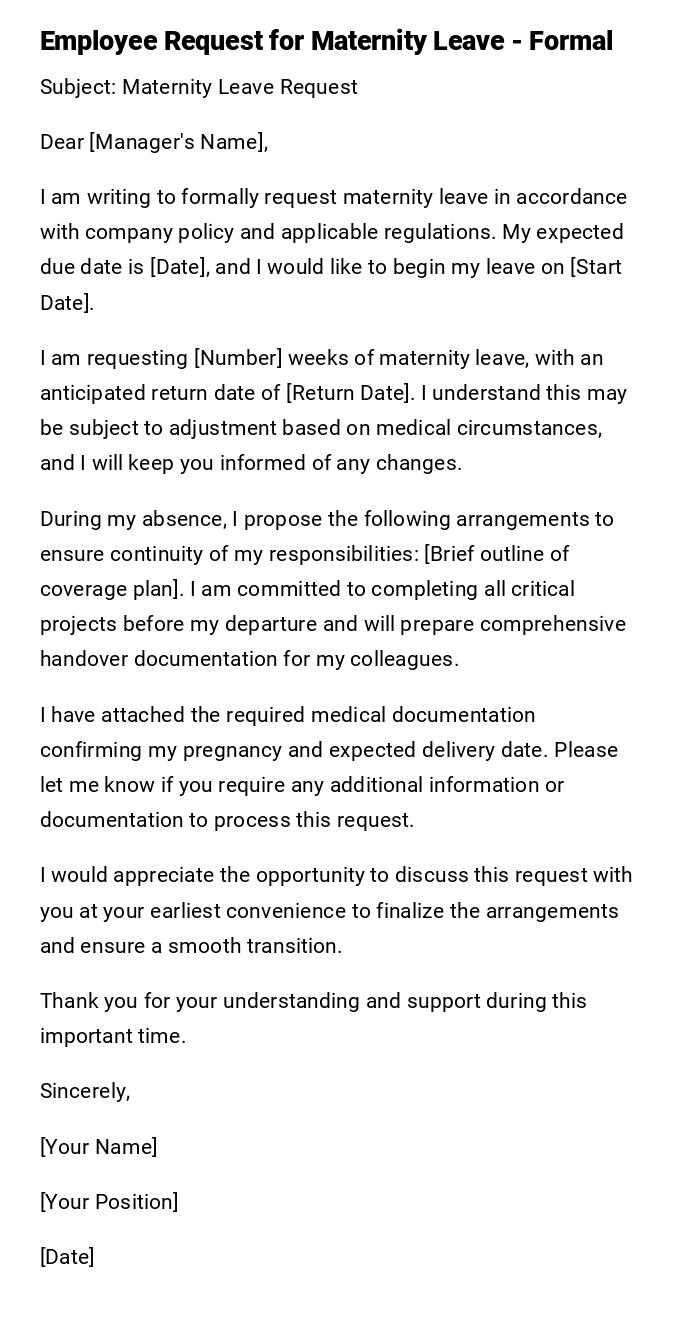
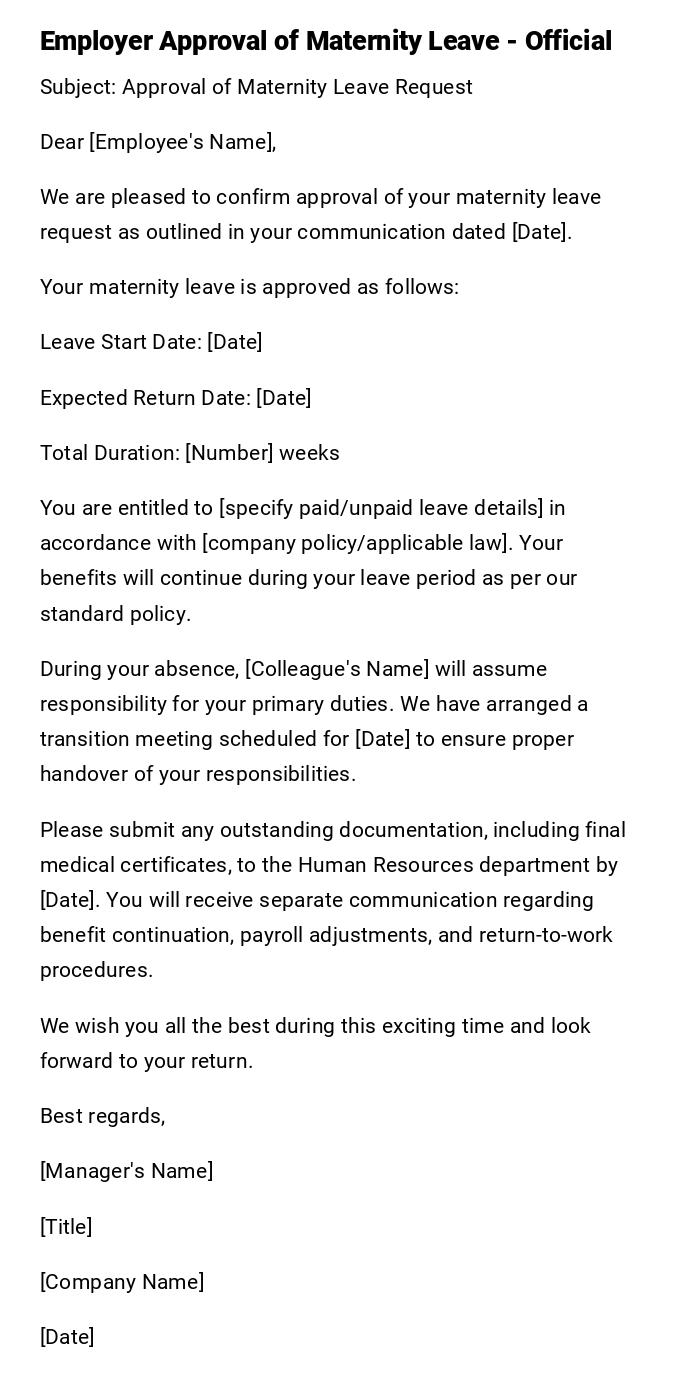
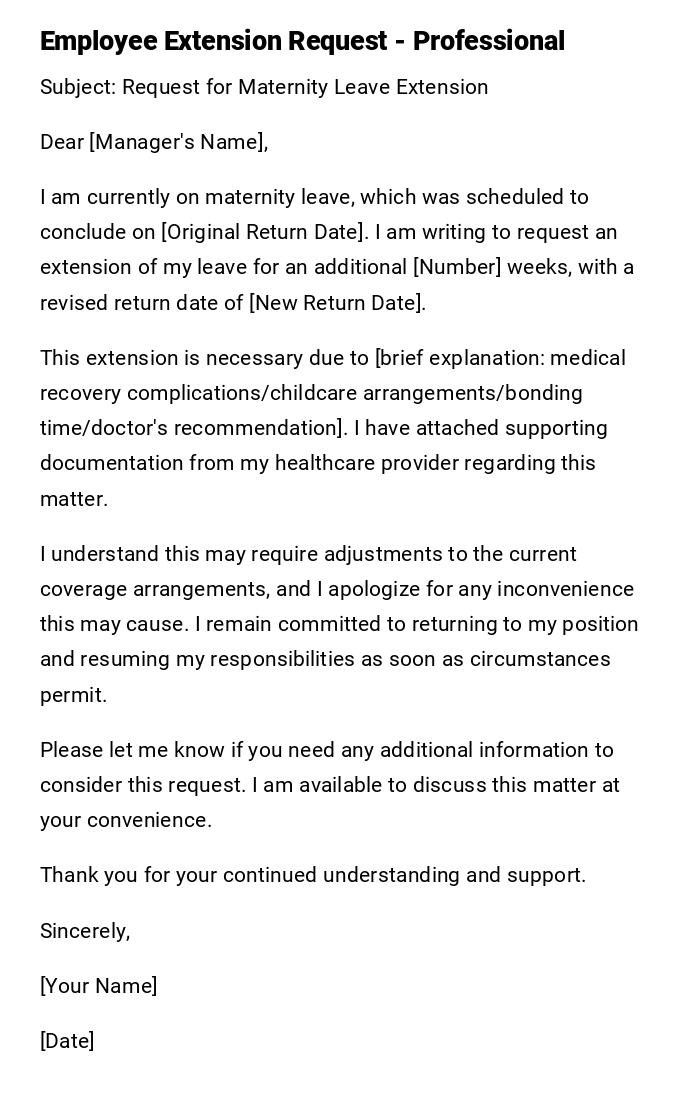
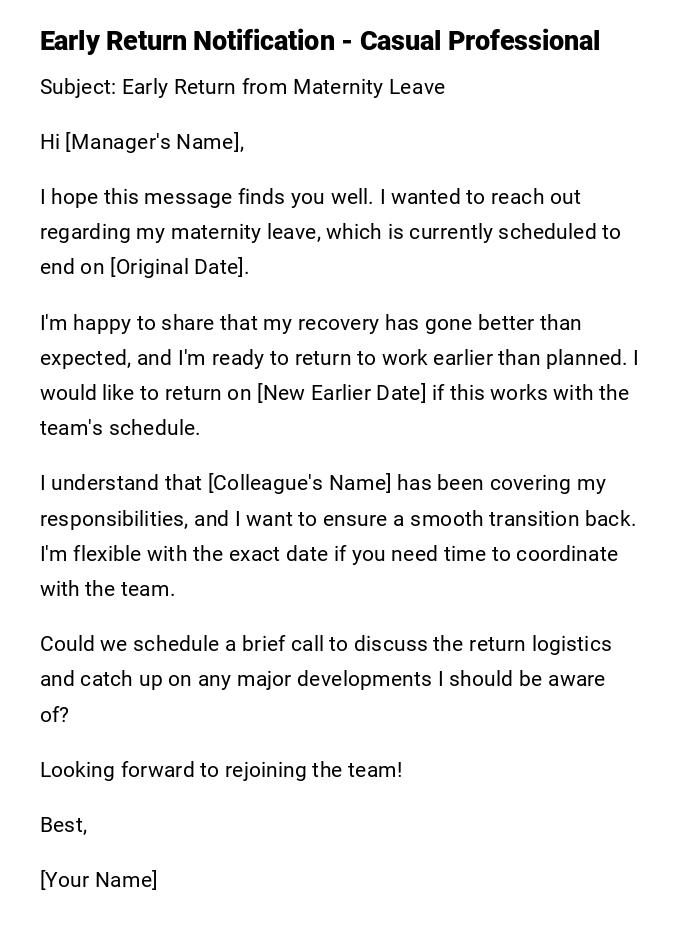
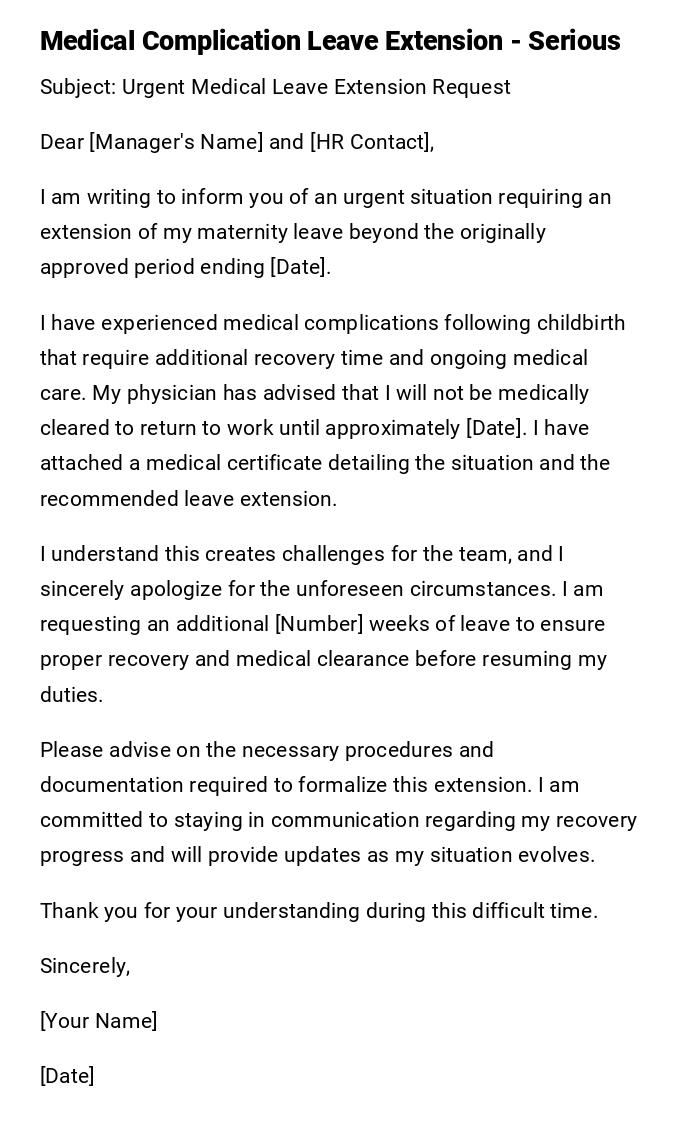
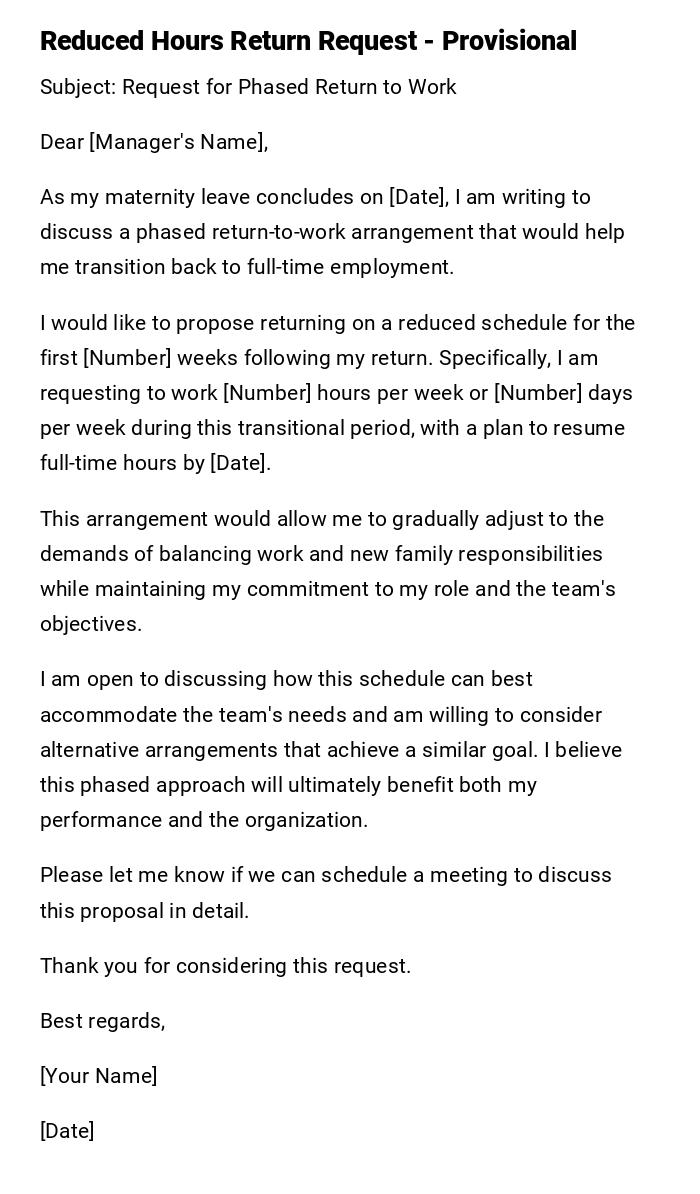
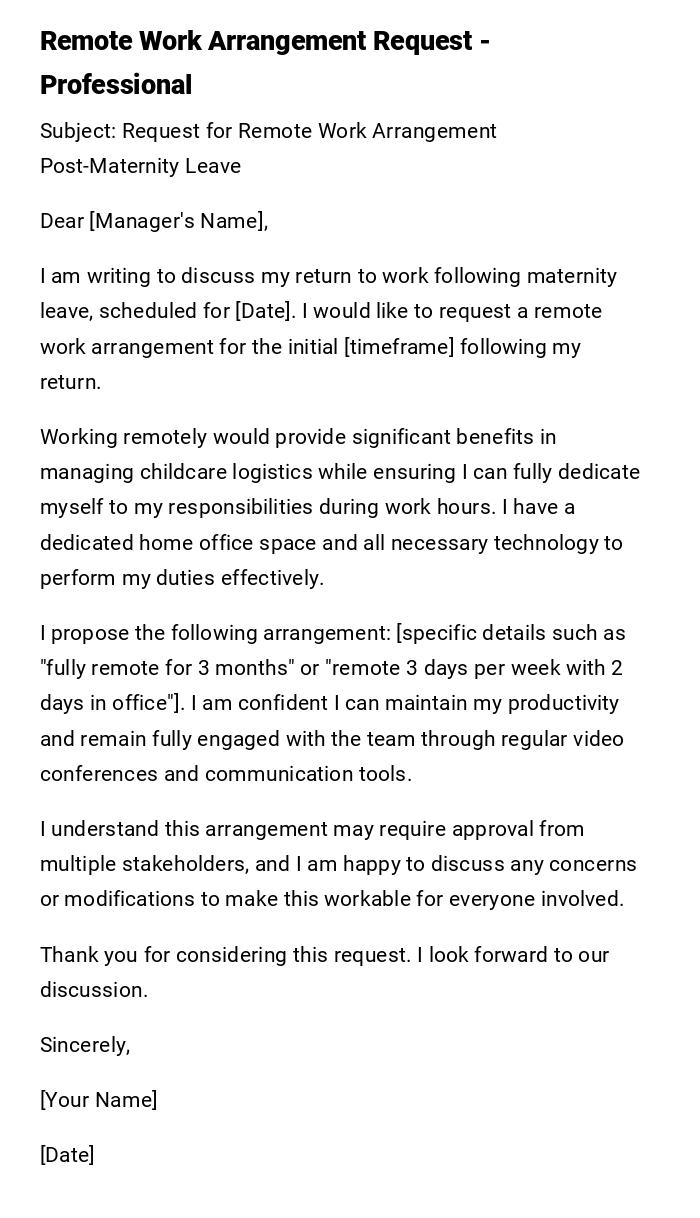
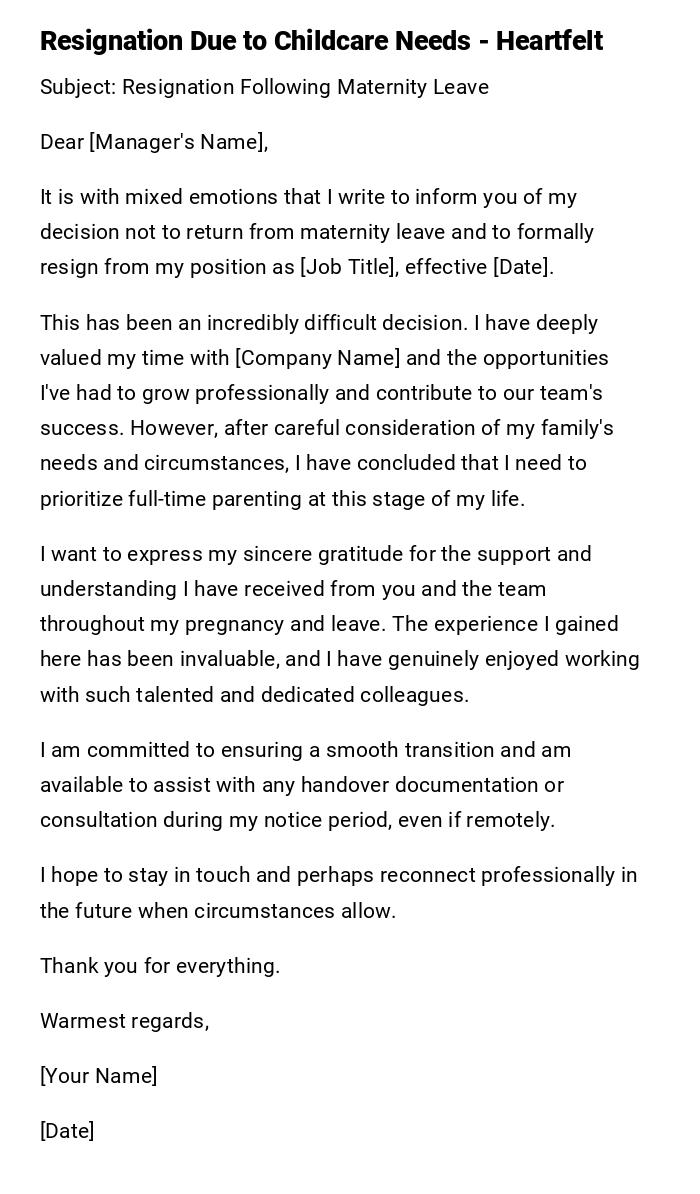

 Download Word Doc
Download Word Doc
 Download PDF
Download PDF